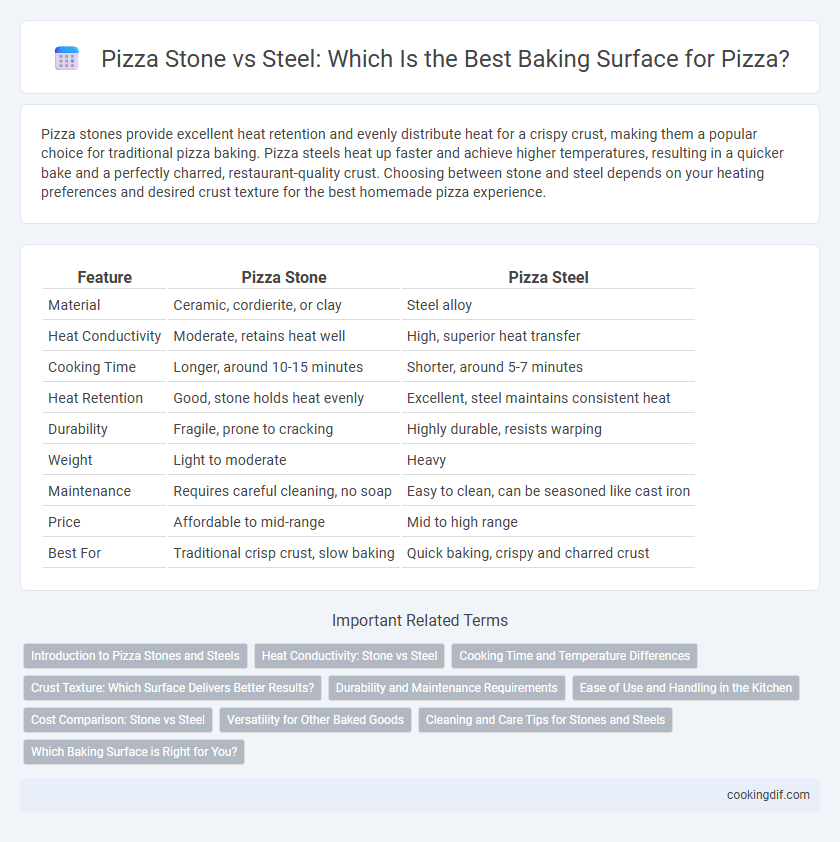Pizza stones provide excellent heat retention and evenly distribute heat for a crispy crust, making them a popular choice for traditional pizza baking. Pizza steels heat up faster and achieve higher temperatures, resulting in a quicker bake and a perfectly charred, restaurant-quality crust. Choosing between stone and steel depends on your heating preferences and desired crust texture for the best homemade pizza experience.
Table of Comparison
| Feature | Pizza Stone | Pizza Steel |
|---|---|---|
| Material | Ceramic, cordierite, or clay | Steel alloy |
| Heat Conductivity | Moderate, retains heat well | High, superior heat transfer |
| Cooking Time | Longer, around 10-15 minutes | Shorter, around 5-7 minutes |
| Heat Retention | Good, stone holds heat evenly | Excellent, steel maintains consistent heat |
| Durability | Fragile, prone to cracking | Highly durable, resists warping |
| Weight | Light to moderate | Heavy |
| Maintenance | Requires careful cleaning, no soap | Easy to clean, can be seasoned like cast iron |
| Price | Affordable to mid-range | Mid to high range |
| Best For | Traditional crisp crust, slow baking | Quick baking, crispy and charred crust |
Introduction to Pizza Stones and Steels
Pizza stones and pizza steels are popular baking surfaces designed to enhance crust texture and heat distribution. Pizza stones, typically made from ceramic or cordierite, absorb moisture to create a crisp, evenly cooked crust, while pizza steels, composed of steel plates, conduct heat more efficiently for faster cooking and a well-browned base. Both tools improve oven performance by mimicking the high temperatures of traditional brick ovens, providing consistent heat retention and superior pizza crust results.
Heat Conductivity: Stone vs Steel
Pizza steel offers significantly higher heat conductivity compared to pizza stone, allowing it to transfer heat more efficiently and produce a crispier crust in less time. While pizza stones retain heat well and provide even cooking, their lower thermal conductivity can result in longer preheating and baking times. Choosing pizza steel enhances the overall baking performance by delivering rapid and consistent heat directly to the dough's surface.
Cooking Time and Temperature Differences
Pizza steel conducts heat faster than pizza stone, enabling shorter cooking times and higher baking temperatures, often reaching up to 750degF (400degC) for crispier crusts. Pizza stone retains heat well but heats more slowly, requiring longer preheating and typically baking at 500-550degF (260-290degC) to avoid cracking. Faster heat transfer in pizza steel results in quicker crust development, while stone offers more even heat distribution ideal for delicate toppings.
Crust Texture: Which Surface Delivers Better Results?
Pizza steel delivers a superior crust texture by conducting heat more efficiently than pizza stone, resulting in a crispier and evenly browned base. The high thermal conductivity of steel allows for rapid heat transfer, creating an ideal environment for a well-charred, chewy crust. Pizza stones, while offering good heat retention, often produce a slightly softer crust due to slower heat response.
Durability and Maintenance Requirements
Pizza stones offer excellent heat retention but are more prone to cracking and require delicate handling and thorough drying after each use to prevent damage. Pizza steels provide superior durability with a virtually unbreakable structure, resisting warping and cracking over time while demanding minimal maintenance aside from occasional cleaning to avoid rust. Steel surfaces heat more rapidly and consistently, making them a long-lasting choice for frequent pizza baking with reduced upkeep concerns.
Ease of Use and Handling in the Kitchen
Pizza stones offer a porous surface that absorbs moisture for a crisp crust but require careful handling due to their fragility and heavy weight. Pizza steels, made of durable metal, heat up faster and provide even heat distribution while being easier to clean and less prone to cracking. Both options demand preheating, but steels typically simplify the transition in and out of the oven thanks to their structural sturdiness and lighter footprint.
Cost Comparison: Stone vs Steel
Pizza steel typically costs more than pizza stone due to its durability and superior heat conduction, often ranging from $50 to $150 compared to stone's $20 to $80 price range. Steel's higher initial investment can be offset by its longevity and ability to achieve higher baking temperatures, improving pizza crust quality. Stone is a budget-friendly option ideal for casual bakers who prioritize affordability over performance and durability.
Versatility for Other Baked Goods
Pizza steel offers exceptional heat retention and high thermal conductivity, making it ideal for baking bread, cookies, and even roasting vegetables with a perfectly crisp crust. Pizza stone, while excellent for evenly distributed heat and moisture absorption, is more suited for traditional baking items like artisan bread and pizza. For versatile baking applications beyond pizza, steel's durability and rapid heat transfer provide greater flexibility and consistent results across various baked goods.
Cleaning and Care Tips for Stones and Steels
Pizza stones require careful cleaning by avoiding soap and instead scrubbing with a stiff brush to maintain their porous surface, while steel baking surfaces are easier to clean with soap and water due to their non-porous nature. Both materials should be dried thoroughly to prevent rust or cracking, with pizza steel benefiting from occasional seasoning with oil to maintain its rust resistance. Avoid thermal shock by allowing stones and steels to cool completely before washing to preserve their structural integrity and longevity.
Which Baking Surface is Right for You?
Pizza stones offer excellent heat retention and create a crispy crust by evenly absorbing moisture, ideal for home bakers seeking traditional results. Pizza steels conduct heat faster and provide higher temperatures, producing a perfectly charred crust suitable for enthusiasts using high-heat ovens or grills. Choosing between stone and steel depends on your baking style, oven type, and desired crust texture.
Pizza stone vs steel for baking surface Infographic

 cookingdif.com
cookingdif.com